| Article ID | Journal | Published Year | Pages | File Type |
|---|---|---|---|---|
| 4979349 | Journal of Hazardous Materials | 2017 | 31 Pages |
Abstract
Soil attenuation of off-site leaching potential of metallic elements at the two abandoned mine sites was investigated using batch sorption and layered column studies. In batch study, the leachate concentration-specific sorption (Kd*) by downgradient clean soils was in the order of Pb > Cu > Cd > Zn > As for DY site and Pb > As > Cu > Cd > Zn for BS site. In the layered (mine + clean) soil column, element elution was significantly reduced (e.g., no initial flush, retarded peak arrival, and lower peak concentration) while sulfate elution can be an indicator of the dissolution of sulfur-bearing minerals in mine soils. The greatest reduction was observed for Pb and Cu while the lowest was for Cd (2-19%) and Zn (6-51%), consistent with the batch data. Both the reduced elution at slow seepage and concentration drop after flow interruption support the time-limited propensity. In column segments, the sorptive elements (Cu, Pb, and As) were dominantly found in the inlet while less sorptive ones (Zn and Cd) in the outlet. Both batch and column data suggest that the element leaching with mine leachate movement can be greatly attenuated by the interactions with the surrounding downgradient soil during the seepage process.
Keywords
Related Topics
Physical Sciences and Engineering
Chemical Engineering
Chemical Health and Safety
Authors
Juhee Kim, Seunghun Hyun,
